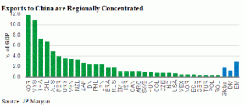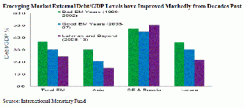Unexpectedly for many, this year began with a return to “risk-off” markets. For instance, the recent slowdown in China’s economic growth , as well as stress in many emerging-markets economies and currency markets, led many to fear that a broader emerging-markets crisis might be at hand. Political turmoil and corruption charges against several high-ranking officials in Turkey, heightened tensions over Russia’s recent standoff with Ukraine and seemingly confused reactions from U.S. and European leaders have done little to calm emerging markets, even if risk assets have bounced back in February and March from January lows. Attempts to draw parallels between the present situation and earlier emerging-markets crises are misguided, however, and, more to the point, stress exhibited by emerging markets is not likely to slow U.S. growth.
On a purchasing-power-parity basis, emerging markets’ gross domestic product accounts for roughly half of overall global output. But developing economies contribute an even more outsize portion of the world’s GDP growth rate: about 70 percent this year by some estimates. Given the deceleration of emerging-markets economic growth, is growth in developed markets, particularly in the U.S., at risk? Ultimately, we do not believe so.
Let’s start with the potential effects of a Chinese slowdown. Export activity to China is largely concentrated within Asia (see chart 1). From the standpoint of the U.S. economy, only a modest portion of its exports head to China, and a fairly small proportion of export activity takes place with emerging markets more broadly. In fact, U.S. exports to emerging-markets countries in aggregate amount to only 5 percent of U.S. GDP, with exposure to the most recently troubled countries accounting for a very small share of the total.
What does this mean for the U.S. recovery? U.S. corporate profits are also not heavily dependent on business activity with emerging markets. U.S. bank exposure to emerging-markets financial assets is modest: less than 6 percent of total bank assets. Exposure to countries most affected by the recent turbulence is even lower. For example, U.S. banks have only about $1.5 billion exposed to Ukraine, suggesting a negligible direct impact on bank asset prices. That said, if the conflict between Ukraine and Russia were to spill over to other countries in the region or affect energy supplies to Western Europe, the economic repercussions would likely be more appreciable.

Further, we are struck by the overall improvement in emerging-markets fundamentals relative to their condition in past crises. For instance, many developing countries, particularly in Asia and Latin America, have much higher levels of foreign exchange reserves and considerably lower degrees of leverage, as measured by the external debt-to-GDP ratio, than in the past (see chart 2). Recent troubles stem in part from externalities derived from developed-market monetary policy responses to the financial crisis of 2008–’09.

Specifically, in the wake of the financial crisis, historically low interest rates in the U.S. and higher real rates in many emerging markets caused massive instances of short U.S.-dollar trading, in which capital flowed out of the U.S. and toward high-yielding emerging-markets currencies. During the third round of quantitative easing by the Federal Reserve, however, most of the world’s central banks were pursuing easy policies as well, so the short-dollar trade was not so obvious. When the Fed began discussions of tapering QE in May 2013, these capital flows reversed sharply, and emerging-markets economies with poor current-account deficits and deteriorating growth prospects began to feel stress. This process was described as a “currency war” by the Brazilian minister of finance in 2010, but perhaps a more apt description would be an adaptation of U.S. Treasury Secretary John Connally’s 1971 quip to foreign finance ministers: “It’s our monetary policy, but it’s your problem.”
Indeed, in a March 3 paper, “Fed Tapering News and Emerging Markets,” Fernanda Nechio, an economist at the Federal Reserve Bank of San Francisco, suggests that there has been a significant divergence in how capital flows have affected various emerging markets and that fundamentals and policies of countries matter a great deal.
Where does this leave us from an investment perspective? There is little doubt that headline risk and volatility are likely to continue to plague emerging-markets assets in the short term. In fact, we think select currencies, such as those of Brazil, India, Indonesia, Turkey and South Africa, known collectively as the “fragile five,” will still be vulnerable to continued depreciation versus the U.S. dollar. Improved valuation levels and solid fundamentals in many areas signal that it is time to make a cautious reentry into select emerging markets, particularly in countries that are adequately funding current accounts and hold a deep pool of resources to mitigate market volatility and potentially slower economic growth. Liquidity and currency volatility will remain risks investors must weigh carefully, but there are opportunities for investing long-term capital in emerging markets, precisely because so many are currently rushing towards the exit.
Rick Rieder is chief investment officer of fundamental fixed-income portfolios for BlackRock.
See BlackRock’s legal disclaimer.
Get more on emerging markets.






